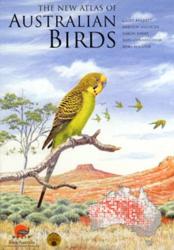Atlas of Australian Birds facts for kids
The Atlas of Australian Birds is a big, ongoing project run by BirdLife Australia. It helps map exactly where all of Australia's bird species live. BirdLife Australia is a not-for-profit group that studies and protects birds.
Many countries have created bird atlases, but Australia's project was the first to cover an entire continent! Volunteers helped collect information on Australian birds. This data was used to create a huge database and publish a book called The Atlas of Australian Birds in 1984. Almost 20 years later, more fieldwork led to a second book, The New Atlas of Australian Birds, in 2002. This project is still going on today!
Contents
The First Atlas: 1984 Book
The idea for an Australian bird atlas, using data from volunteer birdwatchers, started in 1972. It seemed like a huge task! To see if it was possible, a small test atlas was done. This pilot project ran from March 1973 to September 1974. It covered 13,600 square kilometres of the southern coast of New South Wales. About 168 volunteers helped out.
In August 1974, a big meeting of bird experts (the 16th International Ornithological Congress) happened in Canberra. This allowed Australian experts to talk with others who had worked on atlases in different countries. They decided to go ahead with the full Australian project.
Even though volunteers did the fieldwork, some money was needed to manage the project. In February 1976, the RAOU (now BirdLife Australia) got a grant from the Australian Government. This allowed them to hire a full-time staff member. This person's first job was to look through old bird records for a "Historical Atlas." More discussions in 1976 helped decide how the main atlas project would work.
How the First Atlas Worked
The method for collecting data was kept simple. Volunteers, called "atlassers," used maps to find a specific area called a "one-degree grid square." Then, they wrote down every bird species they saw in that square. They also recorded the date and location. This information was written on survey sheets. Later, it was typed by hand into a computer database.
Fieldwork for the first Atlas began on January 1, 1977. It finished five years later, on December 31, 1981. Data was collected from every single one-degree block across Australia, including Tasmania and nearby islands. About 3,000 atlassers completed 90,000 survey sheets. This created 2.7 million records (sightings) of 716 different bird species! The results were published in a book in 1984.
In 1987, a related book, Atlas of Victorian Birds, was published. This book focused only on the state of Victoria. It provided even more detailed information about bird sightings and how they changed with the seasons.
The Second Atlas: 2002 Book
About 20 years after the first Atlas began, in 1997, Birds Australia (now BirdLife Australia) started planning a new atlas project. They talked with Environment Australia to get funding. In 1998, they received a grant from the Natural Heritage Trust.
Fieldwork for the second Atlas started in August 1998. It continued for about four years, until late 2002, when funding ended and the deadline for the book arrived. The methods were similar to the first Atlas, but they were improved. Volunteers used GPS devices to find locations more accurately. They also used special survey sheets that could be scanned into computers.
During this four-year period, over 7,000 atlassers completed 279,000 surveys. This resulted in 4.7 million records of 772 bird species! The second Atlas covered even more areas than the first. Besides the Australian continent and major islands, it included records from Australia's territorial waters and the distant territories of Christmas Island, Cocos (Keeling) Islands, and Norfolk Island. Just like the first Atlas, the results were published in a book called "The New Atlas of Australian Birds."
Ongoing Developments
The Atlas project is still active today! Volunteers can now submit their survey forms online through the Birdata website. BirdLife Australia also uses the Atlas data to publish reports. These reports, like the State of Australia's Birds series, tell us how Australia's bird populations are doing.
The Database
After the first Atlas finished collecting data, not much "atlassing" happened at a national level for a while. However, since the second Atlas book was published, data collection has continued. The Atlas database contains all the information from both published books, plus lots of new data gathered since then. Because of this, BirdLife Australia believes the Atlas database is "one of the most important environmental databases in the world."
The main goals of the Atlas of Australian Birds project are:
- To collect and study information on where Australia's bird species live and how many there are.
- To compare where birds live now to where they lived during the first Atlas.
- To gather information on rare and threatened bird species.
- To get the community involved in protecting and watching over birds.
The success of the bird atlas project led to other similar projects. One famous example is The Banksia Atlas. This project mapped where different Banksia plant species grow. It greatly increased our knowledge of Banksia plants and their habitats. It even led to the discovery of two new species!


